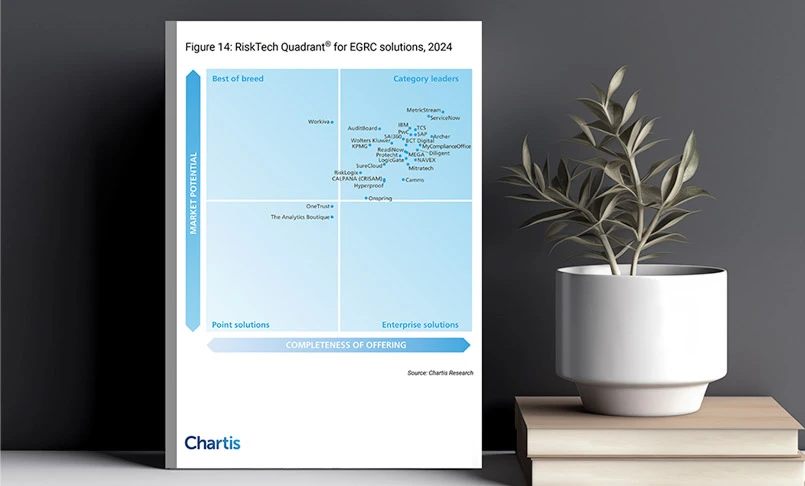Introduction
Today, there is growing pressure to strengthen compliance efforts, especially with the advancement of technology opening up more and more avenues for bad actors to take advantage of weaknesses in the system.
In this ever-evolving environment, a critical aspect of building a successful organization is a strong compliance program, which begins with having a streamlined process with which to maintain compliance documentation, a key component of robust governance, risk, and compliance (GRC) strategy. This ensures that organizations stay ahead of regulatory requirements while minimizing risks and safeguarding their reputation.
Key Takeaways
- Compliance documentation refers to the collection of records, policies, procedures, and reports that demonstrate an organization’s adherence to legal, regulatory, and industry-specific requirements. It serves as evidence of due diligence, ensuring transparency, accountability, and risk mitigation in business operations. Proper documentation helps organizations avoid legal penalties, audits, and reputational damage.
- Compliance documentation is all of the records that help an organization prove that it is adhering to regulations.
- There are several examples of compliance documentation, including policies, training records, risk assessments, audits and more.
- Compliance documentation helps an organization stay current with its adherence to regulations, avoid risk, increase stakeholder trust, and help with growth, amongst other factors.
- Some challenges in maintaining compliance documentation can include the volume of data and its complexity, resistance from employees or management, or even technological or cost-related issues.
- There are a few best practices involved in maintaining compliance documentation, which can include setting up regular training and audits, maintaining version-controlled documents, using tools and automation, and more.
What is Compliance Documentation?
Compliance documentation is a collection of records, policies, procedures, and reports that demonstrate an organization’s adherence to legal, regulatory, and industry-specific requirements. It serves as evidence of due diligence, ensuring transparency, accountability, and risk mitigation in business operations. Proper documentation helps organizations avoid legal penalties, audits, and reputational damage.
Types of Compliance Documents
Compliance documents for companies can vary depending on the industry and regulatory requirements, but they generally fall into several key categories:
Here is your text converted into an HTML formatted list, with the original text unchanged:
- Policies and Procedures: These include guidelines on an organization’s adherence to laws, regulations, and standards to ensure compliance or instructions on the processes required to maintain compliance. Example: A company’s Anti-Money Laundering (AML) Policy that outlines steps employees must follow to detect and report suspicious financial transactions.
- Training and Certification Records: These are documents that prove employees have received compliance-related training or certificates that demonstrate compliance. Example: A signed employee training completion certificate for a cybersecurity awareness program required by industry regulations.
- Risk Assessments and Management: These are reports that evaluate potential risks and outline their mitigation plans. Example: A data privacy risk assessment report identifying potential vulnerabilities in customer data storage and outlining mitigation strategies.
- Audits and Reports: These are reports that log both internal and external audits to prove adherence to compliance requirements. Example: An internal audit report evaluating a company’s adherence to workplace safety regulations.
- Incident and Investigation Reports: This is the documentation of any violations or breaches, and their relevant investigations. Example: A breach report detailing an unauthorized data access incident, including the investigation findings and corrective actions taken.
- Legal and Regulatory Documentation: This includes licenses, permits, contracts and agreements, and regulatory filings. Example: A company’s business license issued by a government authority, allowing it to operate legally in a specific region.
- Monitoring and Reporting Systems: These include compliance checklists and dashboards. Example: A compliance dashboard tracking real-time regulatory compliance status across various departments.
- Certifications and Accreditations: These are official documents confirming that an organization has met certain industry or global standards. Example: An ISO 27001 certification proving that an organization meets international information security standards.
- Data and Record Retention: This is documentation that outlines the schedule for the retention and destruction of certain records, along with actual logs of the process. Example: A document retention policy specifying how long customer financial records must be stored before secure disposal.
- Ethical and Governance Standards: These are documents outlining an organization’s code of conduct and records of any whistleblower activity. Example: A company’s Code of Conduct outlining expected employee behavior and ethical guidelines, with a log of whistleblower complaints and their resolutions.
What is the Role of Compliance Documentation?
Compliance documentation plays a critical role in ensuring that an organization adheres to legal, regulatory, and industry standards. It serves as a record of due diligence, demonstrating that policies, procedures, and actions align with compliance requirements. Key functions of compliance documentation include:
- Regulatory Compliance: Provides evidence that the organization meets legal and industry-specific regulations.
- Risk Management: Helps identify, assess, and mitigate potential risks by maintaining records of risk assessments, audits, and corrective actions.
- Accountability and Transparency: Ensures that all compliance-related processes are documented, creating a clear audit trail for internal and external stakeholders.
- Employee Guidance and Training: Establishes clear policies and procedures that employees must follow to remain compliant with regulations.
- Audit and Investigation Support: Serves as crucial evidence in the event of audits, investigations, or legal disputes, reducing liability and penalties.
- Operational Efficiency: Standardizes compliance processes, making it easier to monitor and enforce adherence across departments.
By maintaining well-organized compliance documentation, organizations can minimize legal risks, build trust with regulators and stakeholders, and ensure smooth business operations.
What is Included in Compliance Documentation?
Compliance documentation typically includes a wide range of materials that demonstrate an organization's adherence to legal, regulatory, and industry standards. The exact contents can vary depending on the industry and regulatory requirements, but in general, compliance documentation includes the following:
- Policies and Procedures: Detailed descriptions of how an organization complies with laws and regulations, covering areas like data protection, health and safety, financial reporting, etc.
- Training Records: Proof that employees have received proper training on compliance-related topics.
- Audits and Reports: Records of internal or external audits that assess the organization’s compliance status.
- Incident Reports: Documentation of any breaches or non-compliance issues and how they were handled.
- Certifications and Accreditations: Documents that prove the organization has met specific industry standards or obtained necessary certifications.
- Risk Assessments: Reports evaluating potential risks and how they are being mitigated.
This documentation is essential for minimizing risks, ensuring transparency, and maintaining the trust of customers, regulators, and stakeholders.
Importance of Compliance Documentation
Compliance documentation is crucial for several reasons, playing a key role in helping organizations manage risk, build trust, and operate within legal and regulatory frameworks. Here are the key reasons for its importance:
- Legal and Regulatory Adherence: Compliance documentation provides tangible evidence that an organization is adhering to laws, regulations, and industry standards. Documentation helps ensure that an organization can demonstrate its efforts to comply with relevant laws and avoid punitive measures.
- Risk Management: By documenting risks and how they are being addressed, compliance documentation helps an organization proactively manage potential issues. It also makes it easier to track compliance issues, investigate incidents, and hold individuals or departments accountable when problems arise.
- Audit Readiness: Audits are much smoother and more efficient when compliance documentation is well-organized and up to date. In addition, regulatory bodies often require detailed documentation during external inspections or audits.
- Operational Efficiency: Compliance documentation ensures that all employees follow the same policies and procedures. Well-documented compliance guidelines help employees understand their roles and responsibilities in maintaining compliance, reducing confusion and minimizing mistakes.
- Building Trust and Credibility: Having thorough compliance documentation shows clients, partners, investors, and other stakeholders that the organization operates responsibly and follows the law. This is especially relevant in highly regulated industries such as financial services or healthcare, where customers tend to be concerned about how their data or assets are being handled.
- Continuous Improvement: Proper documentation allows an organization to track previous compliance issues, corrective actions, and improvements over time. Incident reports and audits provide insight into areas where compliance was weak. By documenting these occurrences, organizations can prevent future violations and ensure continuous learning and improvement.
- Protection Against Liability: In the event of litigation or disputes, having proper compliance documentation can protect the organization by showing that it took the necessary steps to comply with laws and regulations. Codes of conduct or whistleblower policies can protect employees by providing clear guidelines for reporting unethical behavior without fear of retaliation.
- Facilitating Regulatory Changes: Regulations and laws often change, and having existing compliance documentation makes it easier for organizations to adapt by updating policies, procedures, and records in line with new requirements.
- Ethical and Corporate Governance: Compliance documentation often includes ethical guidelines and codes of conduct. Proper documentation supports strong corporate governance by establishing clear rules, policies, and processes that guide decision-making and accountability across the organization.
- Facilitating Growth and Expansion: For organizations looking to expand into new markets or industries, compliance documentation is critical for meeting new regulatory requirements. Furthermore, potential investors or partners often review compliance documentation to assess the organization’s risk profile. Proper documentation ensures smooth expansion and reduces the risk of compliance-related issues in new territories.
Challenges in Maintaining Compliance Documentation
Maintaining compliance documentation can be a complex task, and organizations face several challenges in doing so effectively. These challenges often stem from the dynamic nature of regulations, the sheer volume of documentation required, and the need for accuracy and consistency. Below are the key challenges in maintaining compliance documentation:
| Changing regulations |
|
|---|---|
| Volume of documentation |
|
| Manual processes |
|
| Organizational challenges |
|
| Data-related challenges |
|
Best Practices For Compliance Documentation
To effectively manage compliance documentation, organizations should follow best practices that ensure accuracy, efficiency, and regulatory adherence. Here are some of the key best practices for maintaining compliance documentation:
- Centralize Documentation: Store all compliance-related documents in a centralized digital repository, such as a document management system (DMS) or compliance management software. In addition, organize files into a clear hierarchy with a master folder containing subfolders for different compliance areas.
- Ensure Accuracy and Completeness: Schedule periodic internal audits of compliance documentation to ensure accuracy and completeness. Develop standardized templates and checklists for creating and updating compliance documents.
- Implement Version Control: Use document version control to track changes, ensure all users are working with the most current version, and maintain an audit trail. Keep a record of older document versions, particularly for documents that require periodic updates.
- Automate Where Possible: Automating the tracking, updating, and reporting of compliance documentation can reduce human error and improve efficiency. Automate reminders for document reviews, updates, and regulatory changes. This helps ensure that compliance documents remain current and employees are reminded of important deadlines.
- Maintain Data Security: Implement role-based access controls (RBAC) to ensure only authorized personnel can access, edit, or view compliance documents. Regularly backup compliance documentation and have a disaster recovery plan in place to prevent loss due to system failures, data corruption, or cyberattacks.
- Create Clear Retention Policies: Establish clear retention policies for compliance documentation based on legal and regulatory requirements. These schedules should outline how long documents must be kept and when they should be securely disposed of. Implement secure disposal procedures for outdated or unnecessary compliance documents.
- Regular Employee Training: Regularly train employees on compliance policies, procedures, and their roles in maintaining compliance documentation. Provide training on how to use the document management system or other tools used for compliance documentation, ensuring employees understand version control, access permissions, and document retention protocols.
- Monitor and Track Changes in Regulations: Assign a compliance officer or team to monitor changes in laws and regulations that affect the organization. Subscribe to regulatory update services or tools that automatically notify the organization of new laws or changes to stay ahead of potential compliance risks.
Why MetricStream?
For organizations that need a structured approach to compliance, MetricStream Compliance Management solution helps you manage a wide range of compliance requirements in an integrated manner. The solutions enables you to easily align policies, standards, regulations, and controls to eliminate inefficiencies and redundancies, along with streamlining compliance processes with workflows, self-assessments, surveys, and issue remediation. It helps make various compliance activities and processes much simpler, including:
- Identifying and managing regulations related to processes and assets
- Prioritizing areas that pose a high risk to compliance
- Assisting with control testing and monitoring Managing day-to-day activities around corporate policies
- Managing regulatory updates on a regular basis
- Creating comprehensive reports
Want to see it in action? Request a personalized demo today!
Frequently Asked Questions
Why is compliance documentation important?
Compliance documentation is important because it provides evidence that an organization is adhering to legal, regulatory, and industry standards, helping to mitigate risks, avoid penalties, and ensure operational transparency. It also supports audits, builds trust with stakeholders, and promotes accountability within the organization.
What is a compliance documentation framework?
A compliance documentation framework is a structured system that outlines the processes, policies, and procedures an organization follows to ensure compliance with legal, regulatory, and industry standards. It provides a clear, organized approach to documenting, managing, and updating compliance-related information.
How often should compliance documents be reviewed and updated?
Compliance documents should be reviewed at least annually or whenever there are regulatory changes, business process updates, or emerging risks that require modifications.
What are some best practices for managing compliance documentation?
Best practices include maintaining a centralized repository, implementing version control, regularly reviewing and updating documents, ensuring accessibility for relevant stakeholders, and conducting periodic compliance audits.
Today, there is growing pressure to strengthen compliance efforts, especially with the advancement of technology opening up more and more avenues for bad actors to take advantage of weaknesses in the system.
In this ever-evolving environment, a critical aspect of building a successful organization is a strong compliance program, which begins with having a streamlined process with which to maintain compliance documentation, a key component of robust governance, risk, and compliance (GRC) strategy. This ensures that organizations stay ahead of regulatory requirements while minimizing risks and safeguarding their reputation.
- Compliance documentation refers to the collection of records, policies, procedures, and reports that demonstrate an organization’s adherence to legal, regulatory, and industry-specific requirements. It serves as evidence of due diligence, ensuring transparency, accountability, and risk mitigation in business operations. Proper documentation helps organizations avoid legal penalties, audits, and reputational damage.
- Compliance documentation is all of the records that help an organization prove that it is adhering to regulations.
- There are several examples of compliance documentation, including policies, training records, risk assessments, audits and more.
- Compliance documentation helps an organization stay current with its adherence to regulations, avoid risk, increase stakeholder trust, and help with growth, amongst other factors.
- Some challenges in maintaining compliance documentation can include the volume of data and its complexity, resistance from employees or management, or even technological or cost-related issues.
- There are a few best practices involved in maintaining compliance documentation, which can include setting up regular training and audits, maintaining version-controlled documents, using tools and automation, and more.
Compliance documentation is a collection of records, policies, procedures, and reports that demonstrate an organization’s adherence to legal, regulatory, and industry-specific requirements. It serves as evidence of due diligence, ensuring transparency, accountability, and risk mitigation in business operations. Proper documentation helps organizations avoid legal penalties, audits, and reputational damage.
Compliance documents for companies can vary depending on the industry and regulatory requirements, but they generally fall into several key categories:
Here is your text converted into an HTML formatted list, with the original text unchanged:
- Policies and Procedures: These include guidelines on an organization’s adherence to laws, regulations, and standards to ensure compliance or instructions on the processes required to maintain compliance. Example: A company’s Anti-Money Laundering (AML) Policy that outlines steps employees must follow to detect and report suspicious financial transactions.
- Training and Certification Records: These are documents that prove employees have received compliance-related training or certificates that demonstrate compliance. Example: A signed employee training completion certificate for a cybersecurity awareness program required by industry regulations.
- Risk Assessments and Management: These are reports that evaluate potential risks and outline their mitigation plans. Example: A data privacy risk assessment report identifying potential vulnerabilities in customer data storage and outlining mitigation strategies.
- Audits and Reports: These are reports that log both internal and external audits to prove adherence to compliance requirements. Example: An internal audit report evaluating a company’s adherence to workplace safety regulations.
- Incident and Investigation Reports: This is the documentation of any violations or breaches, and their relevant investigations. Example: A breach report detailing an unauthorized data access incident, including the investigation findings and corrective actions taken.
- Legal and Regulatory Documentation: This includes licenses, permits, contracts and agreements, and regulatory filings. Example: A company’s business license issued by a government authority, allowing it to operate legally in a specific region.
- Monitoring and Reporting Systems: These include compliance checklists and dashboards. Example: A compliance dashboard tracking real-time regulatory compliance status across various departments.
- Certifications and Accreditations: These are official documents confirming that an organization has met certain industry or global standards. Example: An ISO 27001 certification proving that an organization meets international information security standards.
- Data and Record Retention: This is documentation that outlines the schedule for the retention and destruction of certain records, along with actual logs of the process. Example: A document retention policy specifying how long customer financial records must be stored before secure disposal.
- Ethical and Governance Standards: These are documents outlining an organization’s code of conduct and records of any whistleblower activity. Example: A company’s Code of Conduct outlining expected employee behavior and ethical guidelines, with a log of whistleblower complaints and their resolutions.
Compliance documentation plays a critical role in ensuring that an organization adheres to legal, regulatory, and industry standards. It serves as a record of due diligence, demonstrating that policies, procedures, and actions align with compliance requirements. Key functions of compliance documentation include:
- Regulatory Compliance: Provides evidence that the organization meets legal and industry-specific regulations.
- Risk Management: Helps identify, assess, and mitigate potential risks by maintaining records of risk assessments, audits, and corrective actions.
- Accountability and Transparency: Ensures that all compliance-related processes are documented, creating a clear audit trail for internal and external stakeholders.
- Employee Guidance and Training: Establishes clear policies and procedures that employees must follow to remain compliant with regulations.
- Audit and Investigation Support: Serves as crucial evidence in the event of audits, investigations, or legal disputes, reducing liability and penalties.
- Operational Efficiency: Standardizes compliance processes, making it easier to monitor and enforce adherence across departments.
By maintaining well-organized compliance documentation, organizations can minimize legal risks, build trust with regulators and stakeholders, and ensure smooth business operations.
Compliance documentation typically includes a wide range of materials that demonstrate an organization's adherence to legal, regulatory, and industry standards. The exact contents can vary depending on the industry and regulatory requirements, but in general, compliance documentation includes the following:
- Policies and Procedures: Detailed descriptions of how an organization complies with laws and regulations, covering areas like data protection, health and safety, financial reporting, etc.
- Training Records: Proof that employees have received proper training on compliance-related topics.
- Audits and Reports: Records of internal or external audits that assess the organization’s compliance status.
- Incident Reports: Documentation of any breaches or non-compliance issues and how they were handled.
- Certifications and Accreditations: Documents that prove the organization has met specific industry standards or obtained necessary certifications.
- Risk Assessments: Reports evaluating potential risks and how they are being mitigated.
This documentation is essential for minimizing risks, ensuring transparency, and maintaining the trust of customers, regulators, and stakeholders.
Compliance documentation is crucial for several reasons, playing a key role in helping organizations manage risk, build trust, and operate within legal and regulatory frameworks. Here are the key reasons for its importance:
- Legal and Regulatory Adherence: Compliance documentation provides tangible evidence that an organization is adhering to laws, regulations, and industry standards. Documentation helps ensure that an organization can demonstrate its efforts to comply with relevant laws and avoid punitive measures.
- Risk Management: By documenting risks and how they are being addressed, compliance documentation helps an organization proactively manage potential issues. It also makes it easier to track compliance issues, investigate incidents, and hold individuals or departments accountable when problems arise.
- Audit Readiness: Audits are much smoother and more efficient when compliance documentation is well-organized and up to date. In addition, regulatory bodies often require detailed documentation during external inspections or audits.
- Operational Efficiency: Compliance documentation ensures that all employees follow the same policies and procedures. Well-documented compliance guidelines help employees understand their roles and responsibilities in maintaining compliance, reducing confusion and minimizing mistakes.
- Building Trust and Credibility: Having thorough compliance documentation shows clients, partners, investors, and other stakeholders that the organization operates responsibly and follows the law. This is especially relevant in highly regulated industries such as financial services or healthcare, where customers tend to be concerned about how their data or assets are being handled.
- Continuous Improvement: Proper documentation allows an organization to track previous compliance issues, corrective actions, and improvements over time. Incident reports and audits provide insight into areas where compliance was weak. By documenting these occurrences, organizations can prevent future violations and ensure continuous learning and improvement.
- Protection Against Liability: In the event of litigation or disputes, having proper compliance documentation can protect the organization by showing that it took the necessary steps to comply with laws and regulations. Codes of conduct or whistleblower policies can protect employees by providing clear guidelines for reporting unethical behavior without fear of retaliation.
- Facilitating Regulatory Changes: Regulations and laws often change, and having existing compliance documentation makes it easier for organizations to adapt by updating policies, procedures, and records in line with new requirements.
- Ethical and Corporate Governance: Compliance documentation often includes ethical guidelines and codes of conduct. Proper documentation supports strong corporate governance by establishing clear rules, policies, and processes that guide decision-making and accountability across the organization.
- Facilitating Growth and Expansion: For organizations looking to expand into new markets or industries, compliance documentation is critical for meeting new regulatory requirements. Furthermore, potential investors or partners often review compliance documentation to assess the organization’s risk profile. Proper documentation ensures smooth expansion and reduces the risk of compliance-related issues in new territories.
Maintaining compliance documentation can be a complex task, and organizations face several challenges in doing so effectively. These challenges often stem from the dynamic nature of regulations, the sheer volume of documentation required, and the need for accuracy and consistency. Below are the key challenges in maintaining compliance documentation:
| Changing regulations |
|
|---|---|
| Volume of documentation |
|
| Manual processes |
|
| Organizational challenges |
|
| Data-related challenges |
|
To effectively manage compliance documentation, organizations should follow best practices that ensure accuracy, efficiency, and regulatory adherence. Here are some of the key best practices for maintaining compliance documentation:
- Centralize Documentation: Store all compliance-related documents in a centralized digital repository, such as a document management system (DMS) or compliance management software. In addition, organize files into a clear hierarchy with a master folder containing subfolders for different compliance areas.
- Ensure Accuracy and Completeness: Schedule periodic internal audits of compliance documentation to ensure accuracy and completeness. Develop standardized templates and checklists for creating and updating compliance documents.
- Implement Version Control: Use document version control to track changes, ensure all users are working with the most current version, and maintain an audit trail. Keep a record of older document versions, particularly for documents that require periodic updates.
- Automate Where Possible: Automating the tracking, updating, and reporting of compliance documentation can reduce human error and improve efficiency. Automate reminders for document reviews, updates, and regulatory changes. This helps ensure that compliance documents remain current and employees are reminded of important deadlines.
- Maintain Data Security: Implement role-based access controls (RBAC) to ensure only authorized personnel can access, edit, or view compliance documents. Regularly backup compliance documentation and have a disaster recovery plan in place to prevent loss due to system failures, data corruption, or cyberattacks.
- Create Clear Retention Policies: Establish clear retention policies for compliance documentation based on legal and regulatory requirements. These schedules should outline how long documents must be kept and when they should be securely disposed of. Implement secure disposal procedures for outdated or unnecessary compliance documents.
- Regular Employee Training: Regularly train employees on compliance policies, procedures, and their roles in maintaining compliance documentation. Provide training on how to use the document management system or other tools used for compliance documentation, ensuring employees understand version control, access permissions, and document retention protocols.
- Monitor and Track Changes in Regulations: Assign a compliance officer or team to monitor changes in laws and regulations that affect the organization. Subscribe to regulatory update services or tools that automatically notify the organization of new laws or changes to stay ahead of potential compliance risks.
For organizations that need a structured approach to compliance, MetricStream Compliance Management solution helps you manage a wide range of compliance requirements in an integrated manner. The solutions enables you to easily align policies, standards, regulations, and controls to eliminate inefficiencies and redundancies, along with streamlining compliance processes with workflows, self-assessments, surveys, and issue remediation. It helps make various compliance activities and processes much simpler, including:
- Identifying and managing regulations related to processes and assets
- Prioritizing areas that pose a high risk to compliance
- Assisting with control testing and monitoring Managing day-to-day activities around corporate policies
- Managing regulatory updates on a regular basis
- Creating comprehensive reports
Want to see it in action? Request a personalized demo today!
Why is compliance documentation important?
Compliance documentation is important because it provides evidence that an organization is adhering to legal, regulatory, and industry standards, helping to mitigate risks, avoid penalties, and ensure operational transparency. It also supports audits, builds trust with stakeholders, and promotes accountability within the organization.
What is a compliance documentation framework?
A compliance documentation framework is a structured system that outlines the processes, policies, and procedures an organization follows to ensure compliance with legal, regulatory, and industry standards. It provides a clear, organized approach to documenting, managing, and updating compliance-related information.
How often should compliance documents be reviewed and updated?
Compliance documents should be reviewed at least annually or whenever there are regulatory changes, business process updates, or emerging risks that require modifications.
What are some best practices for managing compliance documentation?
Best practices include maintaining a centralized repository, implementing version control, regularly reviewing and updating documents, ensuring accessibility for relevant stakeholders, and conducting periodic compliance audits.








